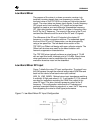
SWRA004A
TRF1500 Integrated Dual-Band RF Receiver User’s Guide 27
2) Set the LO source power (LO P
in
) and the desired frequency
(see Table 3). Connect the LO source to the EVM LO input
port, J12.
3) Set the spectrum analyzer to measure at the IF frequency (see
Table 3).
4) Connect the EVM IF output port, J11, to the spectrum
analyzer.
5) Measure the IF output power (IF P
out
) at the IF frequency with
the spectrum analyzer.
6) Calculate the Cascaded Gain as:
Gain = (IF P
ou
t - RF P
in
) + Transformer Loss. The
transformer loss is 1.8dB.
Example: (-5dBm - (-30dBm)) + 1.8dB = 26.8dB.
The turn on time can be adjusted by changing the values of C10,
R6 and R7, as shown in Figure 21 and Figure 22. The resistors
form a voltage-divider network across the supply, Vcc. The
function of this network is to provide a bias condition near the
ideal operating region at the base of the common emitter amplifier.
By providing this bias condition, the charge time of the series
capacitor, C10, can be adjusted. Changing the value of resistors
should not affect gain, IIP3 or noise figure (NF) performance.
Low-Band Cascaded: Power Conversion Gain Reduction
Control state: 011010
SEE APPENDIX A: TEST BENCH SETUPS
Test setup Figure 20
The Power conversion gain reduction is the delta between the
cascaded IF Pout and the strong signal IF Pout when the strong
signal is enabled. Enabling the strong signal turns off the LNA. It is
measured using a RF source and a spectrum analyzer.
1) Set the RF source power (RF P
in
) and the desired frequency
(see Table 3). Connect the RF source to the EVM RF input
port, J10.
2) Set the LO source power (LO P
in
) and the desired frequency
(see Table 3). Connect the LO source to the EVM LO input
port, J12.
3) Set the spectrum analyzer to measure at the IF frequency (see
Table 3).


















